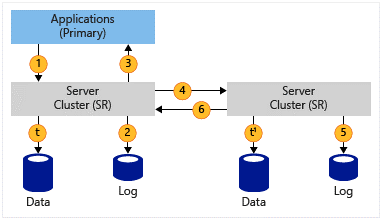Here is an overview dedicated to disaster recovery, more specific, it’s about the DR capabilities of Microsoft Storage Replica – a new feature of Windows Server 2016. It takes a glance on the DR process itself and then brings a few details of the Storage Replica operation, its features, and peculiarities. They include zero data loss, block-level replication, simple deployment and management, guest and host, SMB3 protocol, high security, high performance, consistency groups, user delegation, network constraint, thin provisioning, etc. The post is, basically, an introduction to a series of experiments also listed on the blog. They were conducted in order to check the functionality and performance of Microsoft Storage Replica in different use cases.
Disaster recovery techniques are something you have to keep up with the times with – as with Lewis Carroll’s Red Queen, “it takes all the running you can do, to keep in the same place”. You need to be able to recover quickly when your components fail, even if the reason is a natural disaster. And that’s not just about disaster recovery – you have to ensure disaster preparedness.
Storage Replica is a brand-new feature in Windows Server 2016, which is intended to meet high availability and disaster recovery needs. It provides block-level, volume-based replication, which is meant to avoid the disaster – the data is moved to another site before it is destroyed by the hurricane or something.
There was no feature of this kind in Windows so far. The block-level replication technology has been present in the storage industry but was too expensive due to hardware and software lock-in. And Windows offered only replication at other levels: file-to-file replication – with DFSR (https://msdn.microsoft.com/en-us/library/bb540025(v=vs.85).aspx), applications replication – with log shipping in Structured SQL Server, and VM-level replication – with Hyper-V Replica (https://technet.microsoft.com/en-us/library/jj134172(v=ws.11).aspx).
Storage Replica offers totally new disaster recovery and disaster preparedness options. It gives synchronous data protection at two different sites – buildings, or places, or countries. So, if your data is hit by the disaster in one location, you’ll still have it safe and sound in another location.
There are two working modes for Storage Replica – synchronous and asynchronous replication. At synchronous replication, the application writes data to two locations at once before completion of the IO, which goes for mission-critical data. For longer distances, asynchronous replication is appropriate, as it provides faster response time to application. When the application writes data, that data is replicated to the remote site without immediate acknowledgment.
| Asynchronous replication | Synchronous replication |
 |
 |
|
|
Source: technet.microsoft.com
Storage Replica is simply deployed and managed. It’s storage-agnostic and comes as a feature of Windows Server, which simplifies the licensing issue.
We decided to test Storage Replica in 4 different scenarios:





